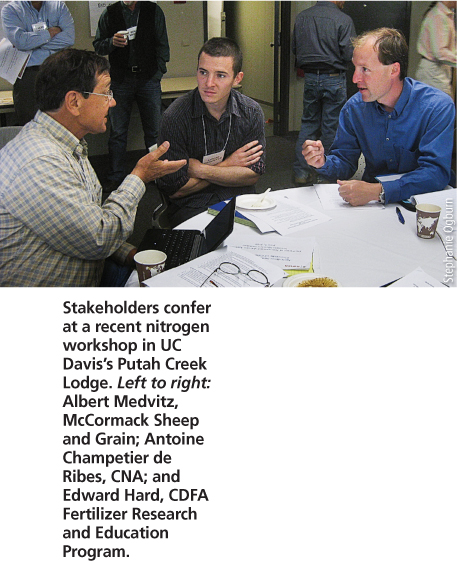All Issues
Unique engagement tools shape nitrogen assessment
Publication Information
California Agriculture 65(2):53-53.
Published April 01, 2011
PDF | Citation | Permissions
Full text
Nitrogen is one of the most important inputs for California agriculture. As fertilizer, it fuels an agricultural system that makes the state a world leader in production. Yet the excess nitrogen that leaks from agricultural systems can cause water and air quality problems that negatively affect ecosystems and human health.
Before leaders can take action to address these unintended consequences, they need a sound scientific foundation on which to make decisions — one that integrates an understanding of the importance of nitrogen to agricultural production. The California Nitrogen Assessment (CNA), an interdisciplinary project of the Agricultural Sustainability Institute (ASI) at UC Davis, is creating this knowledge base with the input of numerous California stakeholder groups.
“The California Nitrogen Assessment will be policy relevant but not prescriptive, which means it will offer a range of possible options and outcomes that stakeholders and policymakers will be able to use to inform their decision-making,” says ASI director Tom Tomich.
To establish a firm scientific baseline, the project comprehensively examines the existing knowledge on nitrogen science, policy and practice in California, using methodology modeled on integrated assessments like the Intergovernmental Panel on Climate Change and the Millennium Ecosystem Assessment. Ultimately, the California Nitrogen Assessment is designed to find leverage points where policy and technology can have a positive effect on California's air and water, and the health of its citizens, while at the same time maintaining the success of its thriving agriculture. Funded in part by a grant from the David and Lucile Packard Foundation, the assessment began in 2009 and will continue through 2011.
Stakeholders confer at a recent nitrogen workshop in UC Davis's Putah Creek Lodge. Left to right: Albert Medvitz, McCormack Sheep and Grain; Antoine Champetier de Ribes, CNA; and Edward Hard, CDFA Fertilizer Research and Education Program.
Stakeholder input
Asking stakeholders to set the research agenda for the assessment is a uniquely important aspect of the project and one that sets it apart from other types of academic research. ASI has met with producers and farm groups, nonprofit leaders, government representatives and others around California, who all helped shape the assessment's focus. Some stakeholders came to the table skeptical about the project, but they quickly became interested in participating.
“The question that you have coming in is, how fair will it be to my point of view?” said Tim Johnson, president of the California Rice Commission. Johnson said that not only has the assessment engaged a wide range of stakeholders, but he has also been impressed “with the quality and the honesty of the dialogue.”
Johnson and other stakeholders participate by serving on the assessment's stakeholder advisory committee, which works in an outreach capacity, sharing assessment information and findings with the groups they represent. Committee members provide specialized feedback to the assessment team in both face-to-face and virtual forums.
“Providing stakeholders with preliminary results and responding to their questions on work-in-progress is unusual for many scientific projects but will help foster results that are more useful to those who use and are affected by nitrogen,” Tomich says.
The future of nitrogen management
Advisory committee members are also participating in a scenario-building process, where they come together in workshops to create plausible stories about how nitrogen will be managed 20 years from now. These stories help participants, many of whom come from diverse perspectives, to address key uncertainties about the present-day landscape.
“It was really interesting to hear a lot of different agricultural perspectives and priorities about the issue,” said Laurel Firestone, co-director of the Community Water Center, a nonprofit addressing the health impacts of nitrates in drinking water.
Paul Martin, director of environmental services for Western United Dairymen, said he is pleased to participate but is concerned about how policymakers will use the results. “The important thing is to avoid the rapid leap to conclusions.”
As the assessment progresses, there will be more opportunities for stakeholder engagement. Drafts of the assessment document will be available for comment in 2011, and the assessment team welcomes the input of any groups or individuals who have a particular interest in the topic of nitrogen in California agriculture.
For more info, go to: http://nitrogen.ucdavis.edu .
—Stephanie Ogburn





